Making Rosace a l’Orange

You can see why this is known as an orange “stained glass” cake. It has a very unique presentation. Also it tastes terrific, which is always a plus. It’s very creamy and Christmas-y with all the candied orange, and delivers a slight alcohol kick. A perfect light closer to a winter evening meal.
You’ll need a couple of days to prep the components for this. The génoise and candied oranges (and maybe also the pastry cream for the diplomat cream) should be made at least a day ahead. Candy the oranges by combining the sugar and the water in a small saucepan.
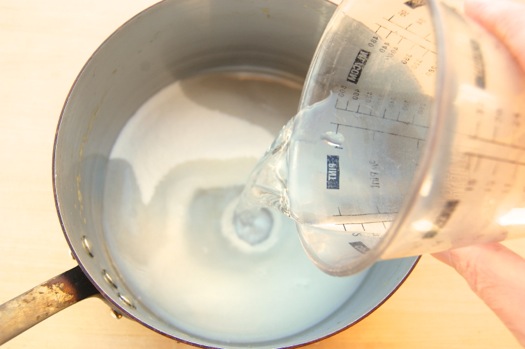
Bring that mixture to a boil, whisking once or twice, then add the orange slices. I used a meat slicer to get very thin, even slices, but a mandolin also works, as does a good steady hand.

Simmer the oranges for two hours until they look about like this. Pour the contents of the pan into a bowl and let them sit out overnight.
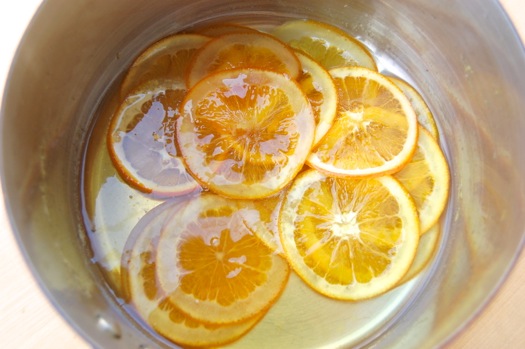
The next day, prepare your mold. A deep pie pan works great for this recipe, provided you line it with plastic wrap like I’m doing here. You want to oil the plastic very lightly…
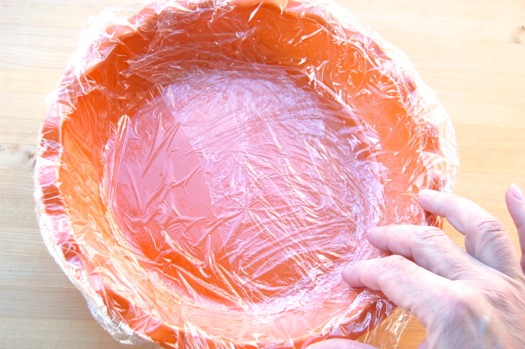
…then scatter on a dusting of granulated sugar. What does this do? It creates a thin layer of syrup which will give the cake a glistening appearance when it’s unmolded. Tap it around, then pour off the excess.
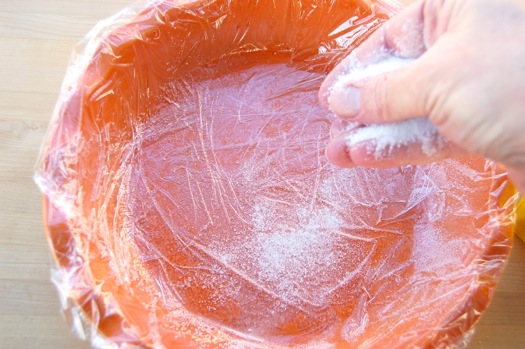
Line your mold with your best slices. If your slices have any tears or holes in them you’ll want to double them up to prevent the cream from peeking through. Chop the rest of the slices finely and set them aside.
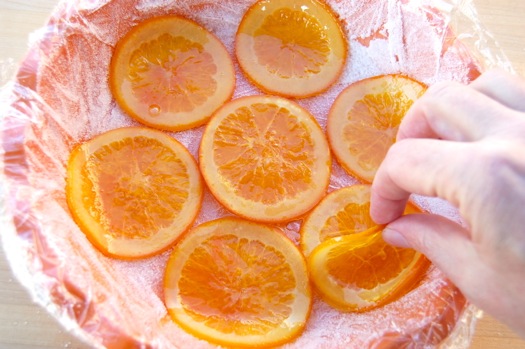
Once that’s done, prepare your génoise cake. Trim off the top so you won’t risk having any brown showing through the cream layer. You don’t have to get every last speck of brown off. I like to freeze the génoise layer ahead of time so it’s easier to cut.

Trim up the sides for the same reason, though odds are you’ll need to do that anyway since the cake layer will probably be a little wide to fit the pie plate.
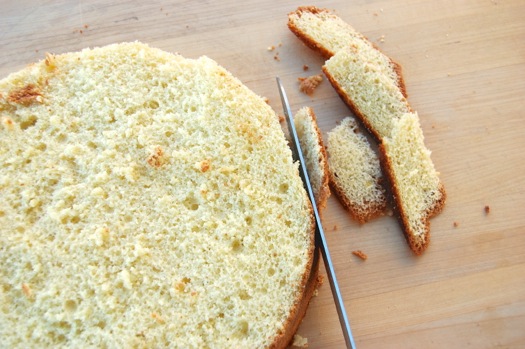
Now cut it in half horizontally. I know, sounds scary, but it really isn’t. just make a shallow cut along the belt line of the layer, going around and around, slowly cutting deeper until….

…you cut through the very center.
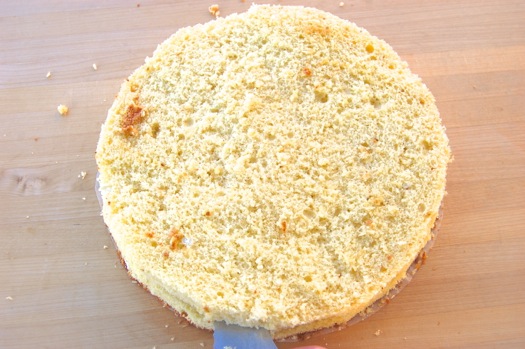
Keep your hand on top the whole time like this though, K?
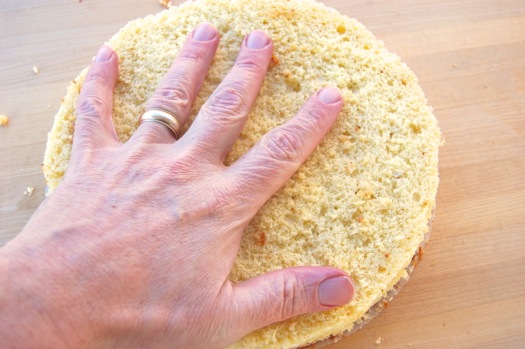
And you’ll have two nice thin layers.
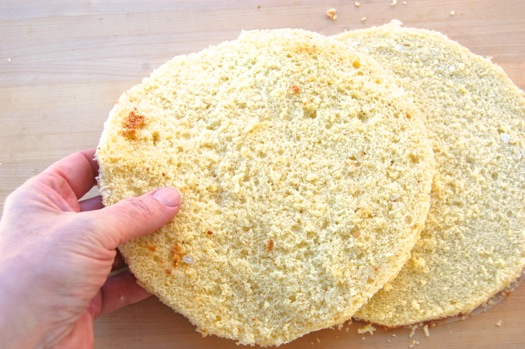
When those are prepared, plop about 2/3 of the diplomat cream into the mold.
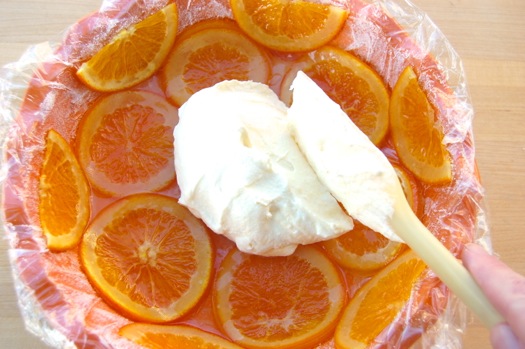
Very gently, so as not to push the orange layers around, spread the cream, pushing it up the sides of the mold.
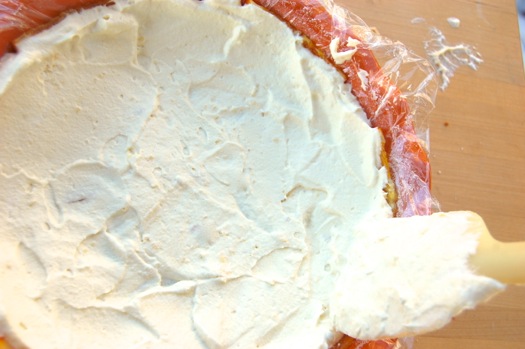
Apply one of the cake layers and using the reserve syrup from the oranges — spiked with a couple tablespoons of Grand Marnier if that’s your thing — dab it around.
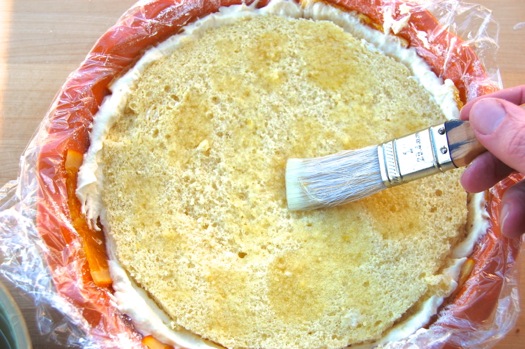
Fold the reserved chopped, candied orange into the remaining diplomat cream and spread that on the layer.
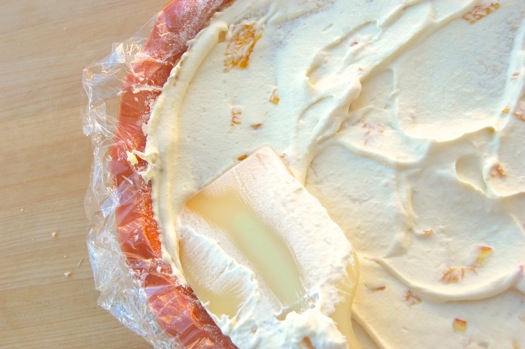
Now dab more syrup on the other layer, on the cut side.
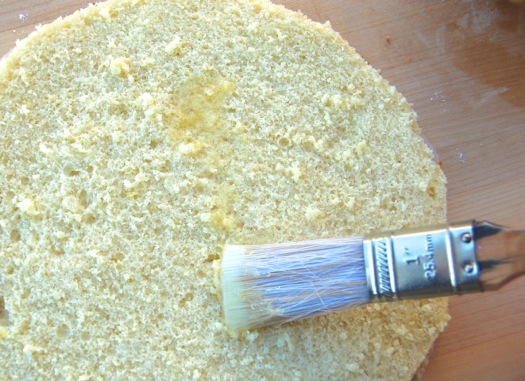
Flip it over onto the mold. It has parchment on the bottom from the cake pan. Peel that off at this point.
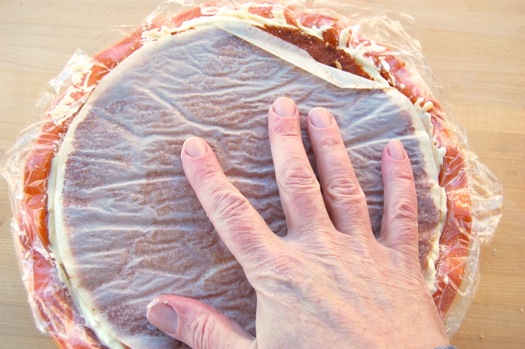
Apply a plate or a cake circle like I have here and press down firmly. Put something relatively heavy on the top (a few cans of peaches or something), then put the mold in the fridge for at least a couple of hours.

To unmold the cake, flip it over onto the cake circle or onto a platter.
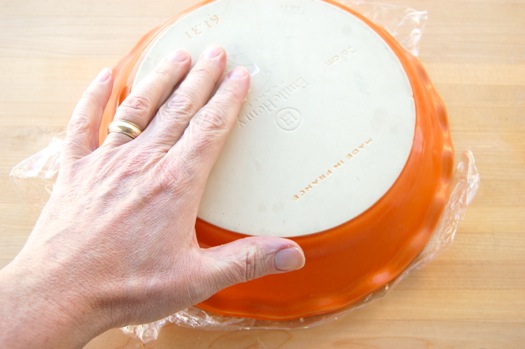
Gently remove the pie pan. At this point you’ll want to put the cake in the freezer for about half an hour to firm the cream on the very outside of the cake. Then gently…oh so gently…peel back the plastic wrap.
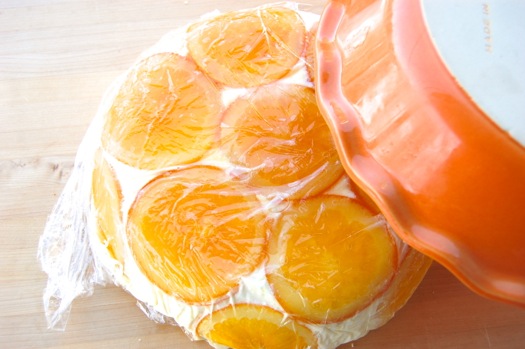
You might have a little dripping syrup or a couple of cream spots to smooth, but here’s roughly what you’ll have.
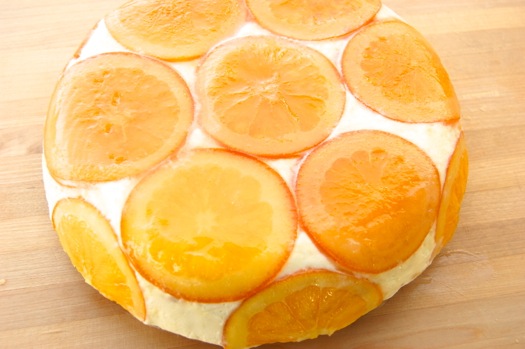
Definitely serve this at the table, since you don’t want to miss out on the oohs and ahs.
Looks so beautiful!!
Thanks, Catherine! Took me a time or two but I eventually figure it out.
Cheerio,
– Joe
You DO make beautiful food! I can imagine that for Easter with bits of purple candied violet laid on some of the white spaces between the orange.
My hat’s off to you, especially, for the lovely candied orange slices. I can do candied peels but I’ve tried to candy slices in the past and all I got were peels with shreds and tatters of pulp hanging on. Oh well, the syrup wonderful for sweetening tea!
That looks so delicious.
looks really good! it’s my favorite orange cake. the flavors are extraordinary. i’ve found the flavor becomes even more interesting by using a soaking syrup for the genoise made of freshly squeezed (unheated) orange juice to which you add some of the candied orange syrup and the grand marnier. a few drops of lemon juice to brighten it up don’t hurt either. i like my genoises more thoroughly moistened than you seem to and am pretty heavy handed on the liqueur. i usually then let the cake mellow a day before serving it to let the flavors fully develop.
it’s great that you’re exposing americans to these more sophisticated french pastries which take a little more work but are worth it. i don’t think there are any other american sites like this that go so methodically through the french pastry to help the more ambitious home baker improve their game. chef eddy has some good stuff, but he posts rarely and then you often have to have bought his book to use the recipe. bravetart is good too but she’s sporadic and not methodical. while there are a number of sites like thefreshloaf that go into professional-level detail for homemade bread fanatics, on the pastry side most american sites (serious eats, the kitchen, etc.) are geared toward simple desserts which can be good but lack the excitement/complexity/wow factor of these cakes and pastries. keep up the good work!
a future topic for exploration might be how much the buche de noel has changed in the past few decades. it’s no longer the simple genoise rolled up with a buttercream filling and frosting anymore.
http://www.mercotte.fr/2013/12/11/buche-de-noel-2013-douce-et-acidulee/
mercotte hosts the televised pastry competition series which has accomplished home bakers prepare french classics that are judged by professionals. (this season one of the challenges was the fraisier!)
http://www.m6.fr/emission-le_meilleur_patissier/
an index of her buches from the recent past:
http://www.mercotte.fr/?s=buche+de+noel&x=0&y=0
her recipe collection is a very useful source for more advanced pastry work made accessible to the home cook. unfortunately most americans don’t read french.
They look fabulous, of course, but I didn’t see a “buche” among them. =
And just when I was thinking of adapting this wonderful variation on a Brooklyn Blackout Cake into a buche de noel…. http://food52.com/recipes/22302-brooklyn-blackout-semifreddo-cake
That’s a great idea! Send picture is you decide to do it, please!
– Joe
How long can you hold the assembled ‘cake’ in the fridge before you serve it? 24?
Sweet lord, there has GOT to be a better word for this than cake.
Thank you for all this work, I am so glad you do.
Happy holidays
Hi Jenny!
It can certainly hold for 24 hours, probably longer, though I noticed that the diplomat cream surface get a little uneven after about 36 hours, probably due to the collapsing air bubbles in the whipped cream portion. You can solve that by using a higher proportion of pastry cream in your diplomat cream, about 2-1 should do it.
And it’s my very great pleasure! Have a merry Christmas and a happy New Year!
– Joe
Very, very pretty, Joe! I like the white peeking through – it’s more a retro 2-D geometric pattern than when the slices overlap :
Btw, I made the “fraisier” last weekend with clementine cross-sections on the outside and mixed berries on the inside (making it an “orangier aux petites fruits,” I guess) – I will write more soon, but suffice to say, it was a hit! Someone else took photos that I hope to receive one day 😉 Thanks as always!
Hehe…yeah no question. I just now thought that it looked like wallpaper from a scene in A Clockwork Orange until I realize what a terrible pun that is. But it’s true…it look like retro-70’s stuff for sure.
So glad to hear the fraisier worked so well! Congratulations!
– Joe
WOW! The difference between this one and your first effort is amazing! This one practically glows. It sounds delicious and would be a lot of fun to bring to the table. Thank you for doing all the hard work & then sharing.
Thanks Frankly. This is one instance where the camera really fails to capture it. The “glow” really is amazing in real life. Ascanius’ idea about a thicker syrup was really the key to this…plus the doubling up of some of the slices. If the slices have no holes or tears then the single layer is even brighter. The closest slice in the main shot is a single, and it shows more detail against the white of the diplomat cream. This is a very cool idea for a cake!
I had fun!
– Joe
Made one of these yesterday and my results, while not as pretty as yours, were pretty acceptable. I think I may try to fill in the gaps among the orange slices with other fruit, perhaps strawberries or kiwifruit, next time.
Well done James! Thanks for the email!
– Joe
Hi Joe
I am a Pastry Chef but I never saw this cake. I decided to make it for Christmas. I decided to use a round “kitchen” bowl (you know the type). It came out perfect and delicious. Can you accept pictures?
I cook in an institutional environment, I may try it this summer when our numbers drop way down. I think I may try it with an outer layer of buttercream which will make it a little more stable. If I use buttercream, I’ll make a buttercream/pastry cream mousseline.
I was also making my version of a separated sponge for a buche, so I made an extra sheet and used this as my cake layer. It wasn’t “tough” but it worked well!
Thanks!!
Hello Howard!
Thanks very much for the email! I’m very glad it worked out, and would like to see pictures. Send them to joe@joepastry.com. I like your buttercream idea also. Please let me know what your impressions are when you make it because I’ll be curious!
Cheers,
– Joe
Hi Joe,
What a beautiful cake! Sometimes I get downright tired of slinging fondant and sugar paste around simply because I don’t like how it tastes. You’ve inspired me to make something similar to your Rosace a l’orange for my dad’s birthday this weekend instead of a fondant covered cake like I’d normally do. I think I might change things up a bit and make the genoise chocolate instead…hmmm, we’ll see. Thanks for the inspiration! I’ll post about it on my blog and definitely refer back to your beautiful creation for credit to being my inspiration. Thanks!
Let me know what you come up with, Cristina! I’ll be interested to see the pictures!
Cheers and Happy New Year,
– Joe